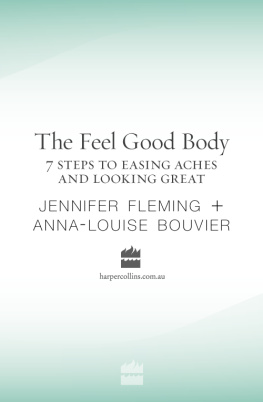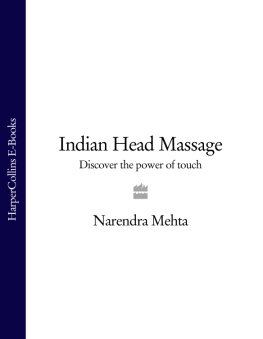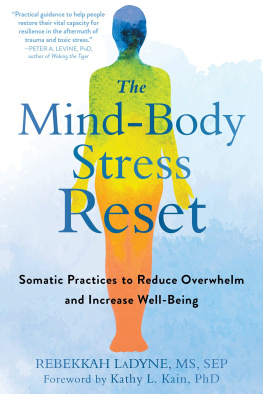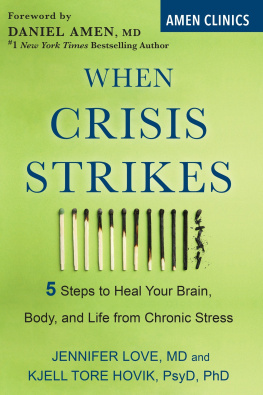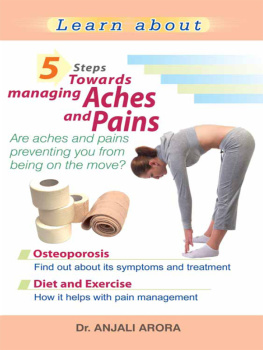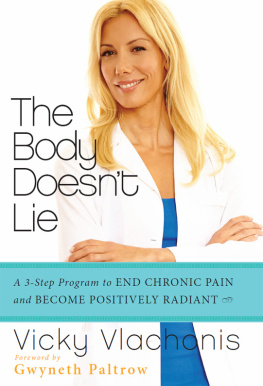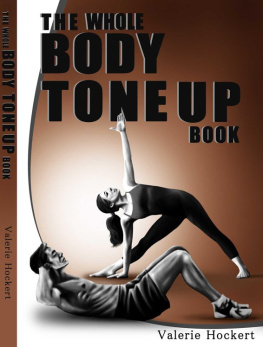While this book is intended as a general information resource and all care has been taken to compile the contents, this book does not take account of individual circumstances and is not in any way a substitute for medical advice. It is essential that you always seek qualified medical advice if you suspect you have a health problem. The authors and publishers cannot be held responsible for any claim or action that may arise from reliance on the information contained in this book.
T here is no reason to feel tired. On my way to an appointment with physiotherapist, Anna-Louise Bouvier, I wonder if my sleep was somehow disturbed and feel annoyed I have a dull headache again. At the top of a narrow set of stairs is a brightly coloured office and Im invited into a consulting room. It is similar to my doctors surgery, with a desk, bed and life-size neck-to-hip plastic skeleton hanging in the corner. Asked to take a seat, I make sure to face away from a large floor-to-ceiling mirror. Do you wake up feeling refreshed? Anna-Louise asks.
The reason Im here talking about my morning mood is not earth shattering or dramatic. I have annoying neck and shoulder pain that I attribute to hours spent tapping away at a computer. For many years I have woken with a dull headache not bad enough to stop me from getting out of bedjust a fog that slowly dissipates. I can live with it. Im also concerned about some injuries when I exercise. As a late starter to fitness, it feels unfair that in trying to keep myself in shape I seem to be falling apart. I worry how I will feel in 10 years. Will my aches develop into something more debilitating and stop me from doing the things I want to do? Is it inevitable that as I age, l will develop a stoop and slowly shuffle along footpaths?
At the end of the assessment, Anna-Louise explains why I experience niggles, headaches and injuries. Your body has the wobbles, she declares. The muscle system supposed to hold you up has collapsed and is placing unnecessary pressure on your neck and shoulders. Like a car with bad wheel alignment, youre getting more wear and tear. Its very common and its very fixable.
I feel relieved to hear this. You were born with a fantastic muscular system that supports and protects your joints. But like most people, you regularly crash this system with sloppy posture. As a result, your body gets the wobbles. When she describes this muscle system to me, I admit Ive never heard of it. Youre not alone. The system lies deep in your body and cant be seen. At the moment, yours and many others bodies are like the Leaning Tower of Pisa, making you more vulnerable to pain and body breakdown.
At the mention of muscles, I expect to be handed a sheet of paper describing a series of exercises to perform; a sheet that would probably end up on a pile of other papers around my house. Changing your body from wobbly to strong isnt about exercises, reassures Anna-Louise. Its about changing everyday habits that will alter how you look and feel.
I first met Anna-Louise during her regular conversations with James Valentine on ABC Radio. Drawn by her humorous and accessible explanations of body ailments, I had also heard about her successful Physiocise program and was keen to discover how it worked. And now Id learned theres a key muscle system that, if activated, could reduce my neck pain and headaches.
Anna-Louise and I began talking about the 21-day Feel Good Body program. There are seven stepsevery three days you focus on a new step until you fix your wobbly body and activate this key muscle system. You will feel better because it reduces strain on your bodyand you will look better for activating your internal elastic support. I know this because Ive done the program and its transformed how I sit, stand, move and exercise.

Wobbly body
Slumpy shoulders, pot tummy, floppy bottom, knock knees, falling arches.

Strong, stable body
Long neck, strong shoulders, sucked-in tummy, lifted bottom, firmer knees, lifted arches.
Kylie, 39
After my second child was born I had severe back pain and was literally unable to walk because my left hip was so unstable. I am now fully functioning. I can walk, lift and carry with confidence. I can even run. And I know if something happens, I can get myself back in line and switch my stabilising muscles back on.
PART A
Whats happening to me?
Chapter 1
The Feel-Good Body approach
W e meet at Anna-Louises favourite second-hand bookstore and caf. Try the corn-fritters, she suggests. And make sure you get the avocado on top. Between mouthfuls, I ask about her different approach to treating patients. When I started as a physiotherapist, I treated patients the way we were taught. Typically, Id see someone who had pain in an area of their body and Id do my best to fix that part of their body. I was a bit like a panel beater fixing a car. Id bang out the dings and send them on their way. Her practice was busy and successful. After a few years though, I became frustrated that despite all my best efforts, and the efforts of my patients, many needed ongoing treatment because they couldnt stay motivated to do their exercises. She pauses before adding, And I think my own experience with back pain influenced me as well.
When she was 19 years old, an accident caused severe pain in Anna-Louises back and her muscles locked up. For years afterwards she felt a dull ache and suffered from bouts of sciatica. Every few months my back would go and Id feel numbness in my left leg. Id madly do exercises to ease the pain and when it stopped, I generally stopped doing the exercises as well. A few months later the pain would come back and Id go through the cycle again. She recognised a similar pattern in her patients, who returned with slightly different versions of the same problems, particularly as they became older. I felt as soon as I plugged one leak in their body, another leak would spring up somewhere else.
She noticed patients continued to break down at the same or similar area because the load or pressure on their bodies was unchanged. A lot of their problems stemmed from poor postural habits becoming strongly cemented in their brains. Treatment only focused on the area of their body that was aching rather than the entire body. I realised I needed to show them how to stop their body wobbles by teaching them how to activate this deep muscle system I call the scaffolding system. When you align the body, you remove the wobbles and make it more stable. The program is about changing habits in order to change brains and bodies.
Anna-Louise designed a program that rebuilds the body to become aligned, balanced and niggle-free. Rather than a short-term fix, its about long-term change. I set about devising a program that shows people how to fix poor posture and activate this crucial muscle system, which in many cases hasnt worked well for years. A big part of the program is showing people how to create new habits. The changes are subtle but the results can be significant because good alignment removes unnecessary pressure from your body.
I ask if a lifetime of body wobbles and poor posture means its too late to correct any problems. Its never too late. Like anything, the earlier you start the better, because theres less wear and tear. But every aspect of your muscle system can be activated and improved at any age.
Each week at her two Sydney clinics, more than one thousand people attend Physiocise classes. These highly successful classes form the basis of the 21-day Feel Good Body program. Its about showing people how to change the way they think about moving, which makes an enormous difference to the way they use their body and the way it responds. Once people recognise how damaging their bad habits are for their body, its motivation to change. It sets them up for years to come.

